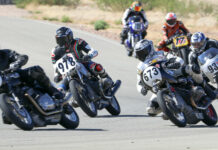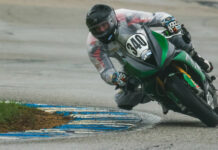By Joe Facer
The red flag is always unlucky for the racer who causes it to be brought out, but it can be lucky or unlucky or both for all the other racers. A restart, if it is early enough in the race, can wipe out a great start or erase a blown start and give you a second chance from your original grid position. If the restart comes later in the race, you can keep your race position when you grid in the previous lap’s race order. It can also allow you to correct a mechanical problem, make suspension adjustments, mount fresh tires, and save the day for you. But you can also find that all the racers that you had worked so hard to leave 10 seconds behind, are now parked alongside or right behind you. Or you can find that the change you made to fix a handling problem while you waited for the restart has now made the bike handle worse.
At Sears Point in 1996, Mat Mladin received a fabulous break when a red flag caused a restart and rescued him from having stalled his bike on the grid during the first start. Aaron Yates got a rotten break in the same race when he went from a 10-second lead to sixth place on the restart, but he also got a fresh set of tires at half distance, something that made his return to the front possible, and he made the most of the fresh tires and won the race. At Road Atlanta in 1999, Mat received a fabulous break when Rich Oliver’s luck went bad and Mat was rescued from a very bad situation that was not of his creation. The racers who were chasing Mat in the Championship missed an opportunity to take the points lead or draw ahead of Mat because of Rich Oliver’s bad luck. Fate gives and Fate takes away and it always favors someone over everybody else. But you cannot lose sight of the fact that the cause of a red flag is invariably that an incident has occurred that poses a substantial hazard to the safety and well-being of the racers. Whether it is a spot of oil or a 5-ton ambulance, the red flag is the surest way to minimize or eliminate the hazard and rider safety is always paramount. Well then, can we find a way to level the playing field and make the red flag situation more fair?
Not as much as we’d like to. There will always be too many red-flag situations in motorcycle racing, it is in the nature of the sport. I’ve had the opportunity to watch some vintage auto and motorcycle racing recently on Speedvision and it is painful to watch some of the early open wheel auto and stock car racing films because of the high standards of safety that we’ve grown to expect in auto racing today. Up until the 1960s, it was not uncommon to see open wheel race cars with the driver dressed in cotton coveralls. Often the driver sat with his head higher in the car than the roll bar, and was fully exposed from the waist up in a car that was no wider than his body, and that did not enclose his arms. When these cars rolled over, the end results were always brutal and often deadly. When you segue from one of these vintage programs to a current auto racing series with cars with full roll cages, five-point safety harnesses, and complete or virtually complete driver coverage, you begin to see why a full-course yellow flag with a pace car is so common in auto racing instead of a red-flag situation.
Roll cages and safety harnesses minimize injuries to drivers and the driver walks away from the typical crash. When the occasional broken bone or concussion occurs, the driver is protected and stabilized within the confines of the roll cage. Life-threatening injuries are relatively rare, even in the fastest cars. The recent death of Dale Earnhardt, an exception to this, has been laid to failed safety equipment/the racer’s choice to forgo a full coverage helmet and optional head and neck restraint, and just plain bad luck.
Advancements in auto racing safety have been significant and widespread. Usually crash cleanup in auto racing is about moving cars off the track or out of impact areas. A full-course yellow flag with pace car keeps the race lap count going while the track is cleared. The cars are bunched behind the pace car in the order they were running and circulated around the track at a very low speed. The race is kept from being overly long and the cleanup is kept safe since the pack appears at the incident at relatively long intervals and at a very slow speed. The track can even be completely blocked with tow trucks and wrecks in the process of cleaning it up while the pack is elsewhere. If need be, the whole field parks behind the pace car while the track is cleared. Many auto races are long enough that pit stops are required or can be accomplished without putting you out of the points. The full course yellow gives teams an opportunity to minimize the impact of a visit to the pits. Pit stops will move cars to the end of the pack but keep them on the same lap if they are quick about it. When you are racing for from one to four hours, or from 150 to 600 miles, a couple of 5 to10-minute sessions at 20 to 40 mph under the yellow flag and behind the pace car does not impact the racing in a major fashion. The full course yellow maintains the continuity of the race and allows spectators at the track and TV viewers to make their own pit stops. This is also an opportunity for the broadcasters to run commercials without cutting away from the racing. When the track goes green, the race gets a fresh start with the pack charging the first turn with all the excitement of the original start. This arrangement appears to work well for auto racing and is widely accepted as fair by the racers, broadcasters, and fans, and firmly incorporated into race strategies.
There are problems with implementing this crash clean-up strategy in motorcycle road racing. As a practical matter, the predominant type of professional and amateur motorcycle road racing in the world today is some form of sprint racing. Most races run from 20 minutes to just under an hour and over distances that can easily be accomplished without pit stops. Races of this type cannot withstand even a moderate interruption or shortening of the racing without profoundly affecting the race character and results. Motorcycles are highly tuned and the bikes and the riders run as close to flat out as they can and still have something left for the end of the race. Of the seven AMA Superbike races at the time of the Road Atlanta incident mentioned above, more than half of them, Daytona, Phoenix, Willow Springs, and first race at Road Atlanta, had Superbike races in which the podium was still in question going into the last lap or the last turn, or in which a conservative riding strategy up until the last few laps of the race played a major part in the finish. A 10-to-20-minute stretch of running at a third of racing speed under the full-course yellow flag would eliminate much of the race. Interruptions of the races or shortening the laps spent at racing speeds should be avoided if at all possible.
To be continued…






